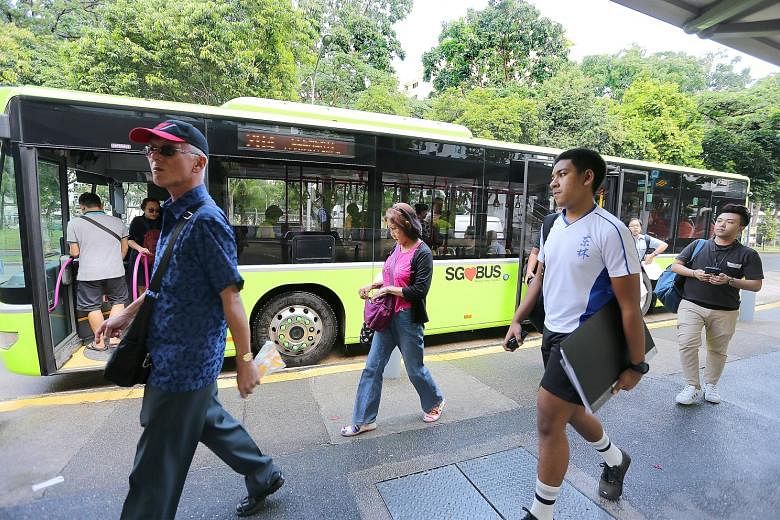Bus service 284 offers a commute that takes users a hop, a skip and a bus ride away.
Three stops and they are back where they started.
The service begins at Clementi bus interchange and trundles along Clementi Avenue 4. At the end of the road, it U-turns and returns to the interchange. The feeder bus service trip lasts all of 15 minutes.
At just 1.7km long, this is Singapore's shortest bus loop route.
By contrast, the country's longest feeder service is 10 times the distance - at 17.4km. Bus service 912 in Woodlands checks in and out of 40 bus stops. The round trip clocks in at about 70 minutes.
Short or long, feeder bus services are the local faces of public transport. They perform the low-key but vital function of connecting residents from major transport nodes, such as bus interchanges and MRT stations, to the bus stop in front of their homes.
Regular bus drivers become the friendly neighbourhood "uncle" or "auntie".
-
1.7km
Distance of the shortest feeder bus loop route.
17.4km
Distance of the longest feeder bus route.
67
Number of feeder bus services.
Take, for instance, Mr Goh Chin Hee, who helms the 1.7km-long service 284 route, along with service 285, which traverses a longer 7.7km. Both are operated by Tower Transit.
On his name tag sits a rabbit-shaped sticker. "A little boy, about four years old, gave it to me in February. He calls me 'happy uncle' and he tells his mother he wants to take only my bus," said Mr Goh in Mandarin, with a laugh.
"To a child, a sticker is a very precious item. I had to paste it on my name tag," he told The Straits Times in an interview at the Bulim bus depot, during his three-hour midday break.
He is on the permanent split shift, which sees him on the road for a total of nine hours a day. During each shift, he makes at least 20 trips on service 284, with six to eight minutes of rest in between.
But the job never gets boring, Mr Goh said. Rather, it is a sense of duty and the interactions he has with the commuters that keep him going.
"No matter long or short, all the bus routes fulfil a demand. My attitude towards my job is to always do my part well, regardless of which route I drive," he said.
For many Clementi residents, Mr Goh is the first and last person they meet on their commutes.
A former container truck driver of eight years, he started plying both routes six days a week around three years ago, and has since forged a close bond with regular commuters.
Some chat with him when they board the bus, while others have gifted him food, such as rice dumplings or barbecued meat, on festive occasions.
He is also in the midst of planning a trip to Hainan Island in China with a friend in his 80s, whom he first met on the job.
The route may be short, but is important for the residents who live in the HDB blocks along Clementi Avenue 4, he said. It also caters to those living nearby at the private-estate enclave of Sunset Way.
Some may say that the distance is so short it does not make sense. For instance, Clementi Town Centre is less than 10 minutes away by foot.
But ridership on service 284 remains "quite high", with buses running at five-minute intervals during peak hours, said Mr Goh. Tower Transit and the Land Transport Authority (LTA) declined to share ridership figures.
"There are many elderly residents in Clementi and, for them, (taking the bus) is just more convenient," said Mr Goh. "On weekends, some push their trolleys and take the bus to get to the market."
For Madam Chew Chua Lian, 73, who has been living in Clementi for about 20 years, taking service 284 allows her to beat the weather.
"Without the bus, I would have to walk under the hot sun in the afternoon. Rainy days will also be troublesome," said the part-time cleaner, who takes the service at least four times every day to work two shifts at the post office in the town centre.
Singapore currently has 67 feeder bus services, making up some 20 per cent of the 342 public bus routes - trunk, express, limited stop and night services - in the transport network.
The idea of feeder bus services was first explored in 1974 by the Singapore Bus Service, as a way to improve peak-hour travel.
It was introduced the following year in Toa Payoh, which was the largest housing estate then with more than 300,000 residents.
Commuters paid a nominal fare of 10 cents, compared with a minimum fare of 20 cents on other buses, and a 1975 opinion poll showed positive response from many Singaporeans.
Now, adult commuters pay up to 77 cents when they use their ez-link cards, while student fares are capped at 37 cents.
Feeder services were later extended to other satellite towns, such as Bedok, Jurong and Tampines, even before the MRT system began in 1987.
Today, Woodlands town has the most number of feeder services, according to the LTA.
"The number of feeder services in each town typically depends on the size and layout of the town," said an LTA spokesman. "New feeder services, such as in Choa Chu Kang, Punggol and Sengkang, are introduced when there are new developments."
Despite the many changes to the public transport network over the years, including the extension of LRT lines and the growing popularity of modes such as electric scooters and bikes, National University of Singapore transport researcher Lee Der Horng believes that feeder services will remain relevant, going forward.
"Singapore is configured based on Housing Board towns. In the future, the primary goal of feeder buses will still be in taking people to their regional transport centre, providing the first- and last-mile connectivity," he said.
But as the MRT network grows in coverage and mileage in the coming years, commuters will demand feeder services to be even more regular and timely, he added.
"Commuters expect any plans in the future to make every stage of their journey seamless," he said.
And while this means the job of a bus driver may become tougher in the future, Mr Goh, who is zen about it, said: "We cannot control the traffic conditions, and commuters may get upset when their bus is late, but we have to keep smiling. It may help, even in a small way."



